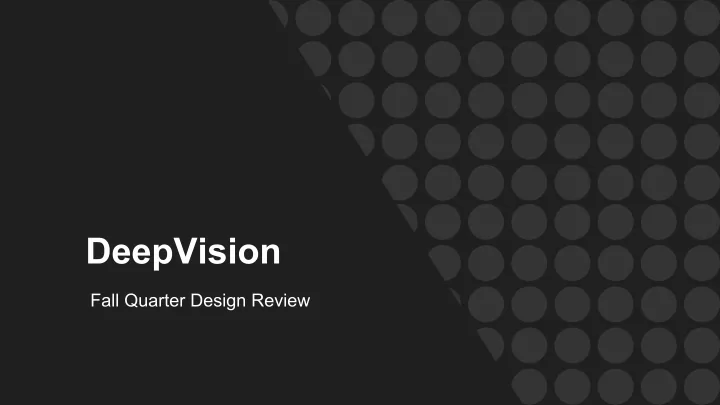

DeepVision Fall Quarter Design Review
Purpose We aim to build a Deep Neural Network Image Recognition and Detection algorithm on a embedded GPU device Attending 2018 DAC Contest Sponsored and collaborated with Prof. Xie and SEAL LAB Finally implemented on drones as well
Software - Algorithm ❏ Detect and tracks people and objects in video captured by drones. ❏ Problem with conventional tracking algorithm without deep learning... ❏ Deep learning - use training dataset to train computer to recognize people and be able to track them, even in difficult scenarios. ❏ We are implementing our design based on the state- of-the-art YOLO algorithm ❏ Energy Consumption vs. Throughput
2018 DAC ● Features embedded system Contest implementation of neural network based object detection for drones ● Two categories by platform: FPGA and GPU. we registered GPU category, hardware provided by the contest ● Evaluations
Update On Contest ● Received Hardware Jetson TX2 ● IO Specification set ● Detection and tracking ● Speculation on focusing on optimization ● First implementation due in January for evaluation
YOLO ● Unified Detection ○ x, y, w, h, c
YOLO ● The Darknet framework ○ Inspired by GoogLeNet
YOLO ● Training Algorithm ○ More layers ○ Higher resolution ○ Optimized loss function ○ Adjusted learning rate ○ Dropout and extensive data augmentation
YOLO to YOLOv2 ● Better ○ Direct location prediction ● Faster ○ Darknet-19 ● Stronger ○ Hierarchical classification
Improvement ● Implement YOLO on PyTorch instead of in C and Tensorflow. ○ More easy-to-use library package ○ More simple and concise compared to Tensorflow ● Create the model in a more explicit way ○ The open-source code is too complex ● Focus on reducing energy ○ Network compression ● Switch back to C and CUDA at the end ○ Remove the library wrapper ○ For better performance
Hardware - Nvidia Jetson TX2 ● Ubuntu 16.04 LTS ● Jetpack 3.0 SDK ○ Deep Learning: TensorRT, cuDNN, NVIDIA DIGITS™ Workflow ○ Computer Vision: NVIDIA VisionWorks, OpenCV ○ GPU Compute: NVIDIA CUDA, CUDA Libraries ○ Multimedia: ISP Support, Camera imaging, Video CODEC Drone sends back video to be processed on GPU. Main Difficulty: Interface between the board and drones.
PARROT BEBOP 2 Camera: 14 mega-pixels with fish-eye lens Video resolution: 1920 x 1080p (30 fps) Battery life: 25 minutes flying time (with 2700 mAh battery) GPS: Yes Processor: Dual core processor with quad-core GPU Storage: 8 GB flash storage system Connectivity: Wi-Fi 802.11a/b/g/n/ac Signal range: 300 m
ARDroneSDK3 Platform: IOS, Android, Linux ● Discover the drones on the network ● Connect the drones ● Send piloting and camera commands ● Configure the drones ● Get informations (depends on drones capabilities) ● Get H264 video stream on bebop ● Get MJpeg video stream on Jumping Sumo ● Transfer photos / videos ● Update the drones ● Handle Drone Academy / Mavlink files
Block Diagram
Demo Using YOLO on pytorch to detect and track objects Video
Team Responsibility Charlie Xu Group leader, Algorithm Design Terry Xie Software Framework, Hardware Interface Design Jenny Zeng Deep Learning Algorithm Design Chenghao Jiang Hardware and Software Interface Design
Project Report We have a working algorithm running on TX2, implementation of YOLO on Pytorch, able to train and get the right result. 14fps and 76 mAP
Future Plans Optimize YOLO - Improve fps and accuracy, limit power consumption Update each month See how we do on the contest Final Goal: After we have our version of the algorithm, implement it on drones.
Questions?
Collaborators / Mentors / Sponsor Prof. Yuan Xie (UCSB SEAL LAB) Xing Hu (UCSB SEAL LAB) Liu Liu (UCSB SEAL LAB) Prof. Yogananda Isukapalli (ECE 189) NVIDIA (SPONSOR) DJI (SPONSOR)
Recommend
More recommend